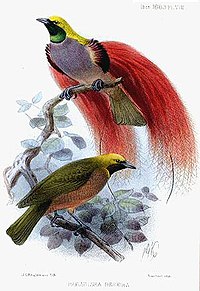
Photo from wikipedia
Abstract The evolution of male preferences and of female ornaments in species with traditional sex roles (i.e., polygyny) have been highlighted as areas in need of more active research by… Click to show full abstract
Abstract The evolution of male preferences and of female ornaments in species with traditional sex roles (i.e., polygyny) have been highlighted as areas in need of more active research by an accumulation of recent findings. The theoretical literature on these topics is relatively small and has centered on the evolution of male choice. Mathematical models have emphasized that, under polygyny, the evolution of male preferences faces much greater competition costs than does the evolution of female preferences. We discuss ways in which costly male choice can nonetheless evolve, via (1) direct selection that favors preferences, primarily through mating with highly fecund females, (2) mechanisms that rely on indirect selection, which weakly counters competitive costs of male preferences, and (3) genetic constraints, primarily in the form of pleiotropy of male and female preferences and traits. We also review a variety of mathematical models that have elucidated how costs to male preferences can be avoided. Finally, we turn our attention to the relatively scant theoretical literature on the effects of male mate choice on the evolution of female traits. We emphasize the finding that the presence of male preferences cannot be assumed to lead to the evolution of female ornaments during polygyny, and point out situations where models have elucidated ways in which female ornaments can nevertheless evolve.
Journal Title: Current Zoology
Year Published: 2018
Link to full text (if available)
Share on Social Media: Sign Up to like & get
recommendations!